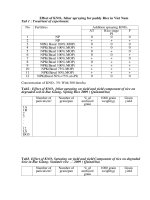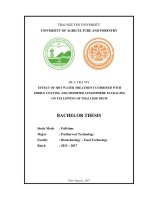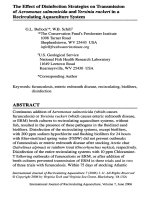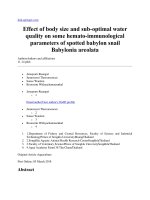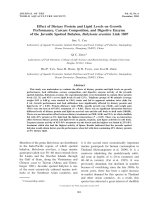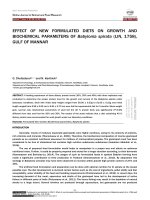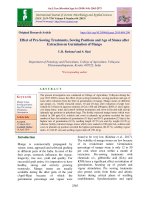Effect of pre-harvest foliar spray of chemicals and mulching on fruit yield, quality and marketability of Mango cv. Langra
Bạn đang xem bản rút gọn của tài liệu. Xem và tải ngay bản đầy đủ của tài liệu tại đây (461.76 KB, 12 trang )
Int.J.Curr.Microbiol.App.Sci (2020) 9(3): 648-659
International Journal of Current Microbiology and Applied Sciences
ISSN: 2319-7706 Volume 9 Number 3 (2020)
Journal homepage:
Original Research Article
/>
Effect of Pre-harvest Foliar Spray of Chemicals and Mulching on Fruit
Yield, Quality and Marketability of Mango cv. Langra
Ravindra Kumar1*, V. B. Patel1, Amit Raj1, Sanjay Sahay1,
K. P. Singh2 and Samik Sengupta1
1
Department of Horticulture (Fruit and Fruit Technology), 2KVK, Katihar, Bihar Agricultural
University, Sabour, Bhagalpur-813210, India
*Corresponding author
ABSTRACT
Keywords
Mango, pre-harvest
foliar spray, shelflife, fruit quality,
marketability
Article Info
Accepted:
05 February 2020
Available Online:
10 March 2020
Pre-harvest foliar spray of chemicals and mulching is an important technique to extend the
self-life, marketability as well as fruit quality of mango. Keeping in view the experiment
was conducted under the experimental area of BAU, Sabour, Bhagalpur, Bihar, India
during the two successive seasons of 2012 and 2013. Thirty-year-old mango cv. Langra
trees were used with eight treatments along with polythene mulching (during October) and
per-harvest chemicals were sprayed at 30 days before harvesting of fruits of CaCl 2 6H2O
@ 2, 4 and 6%,Ca (No3)2@ 4%, K2SO4@ 1.0% and borax @ 1.0% in combination with
polythene mulching and control. On the basis of pooled analysis of two years data. The
treatment borax @ 1 % with mulching was performed better in respect of increasing the
fruit weight (306.38g) and yield (132.13 kg tree-1). This treatment was also found effective
for increasing the TSS (13.83 & 20.96 0Brix) and for decreasing the acidity (0.818 &
0.326%) at the time of harvest and end of storage period respectively. Whereas, the end of
storage period minimum softness percentage (11.88%), minimum physiological loss in
weight (15.40%) and maximum fruit marketability (87.50%) were observed with the
treatment of CaCl2 6H2O@ 2% in combination with mulching. Thus, the observations
indicated that per-harvest application of CaCl2 6H2O @ 2% is effective for improving the
fruit shelf-life and decreasing the physiological loss in weight (PLW) whereas; the borax
@1.0% with mulching proved effective for improving the fruit quality of mango cv.
Langra.
known as “King of fruits” due to its delicious
taste, attractive colour and nutritional value.
A fully matured fruit contains a high level of
sugars (16-18 % w/v) with blending of acidity
and antioxidants medicinal value like
carotene. In respect to big demand of the
larger population the availability of mangoes
Introduction
Mango (Mangifera indica L.) is a very
popular fruit crop of family Anacardiaceae in
India as well as tropical and subtropical
countries of the world. India is the largest
mango producing country in the world. It is
648
Int.J.Curr.Microbiol.App.Sci (2020) 9(3): 648-659
is restricted due to lack of adequate
knowledge of post-harvest technique and
inadequate storage and poor transport
facilities resulting in poor fruit quality with
short shelf-life. Mango fruits are also highly
perishable, sometimes due to over-ripening;
they increase susceptibility on viral and
fungus diseases that results into unmarketable fruits (Nagarag et al., 1995).
with the objective of evaluating the effect of
pre-harvest foliar spray of chemicals and
mulching on fruit yield, quality and
marketability of mango cv. Langra.
Materials and Methods
The present investigation on effect of preharvest spray of chemicals for extending the
shelf-life and quality of mango was carried
out on thirty years old mango tree cultivar
„Langra‟. All the plants were selected uniform
in growth and size, which were planted at the
distance of 10 m × 12 m in experimental area
under Department of Horticulture (Fruit and
Fruit Technology), Bihar Agricultural
University, Sabour, Bhagalpur, Bihar during
the two successive seasons 2012 and 2013.
Low fruit calcium levels have been associated
with
reduced post-harvest
life and
physiological disorders (Prabu, 2011). So, to
solve the problem of short shelf-life of mango
fruits, different chemicals are used (Suhardi,
1992). Calcium, potassium and boron are
known to play very important role in
improvement of fruit quality and shelf life of
various fruits. The previous workers have also
demonstrated that calcium play a very
important role in improvement of shelf- life of
fruits (Mika, 1983; Jones et al., 1970).
Calcium has been extensively reviewed as
both an essential element and it has a
potential role in maintaining post-harvest
quality of fruit (Chadha, 2000).
The
experiment
was
conducted
in
Randomized Block Design with four
replications with total eight treatments. The
treatments were comprised of T1-black
polythene mulching, T2- black polythene
mulching + CaCl26H2O @ 2 %, T3- black
polythene mulching + CaCl26H2O @4%, T4black polythene mulching+ CaCl26H2O @
6%, T5- black polythene mulching+ Ca(NO3)2
@ 4%, T6- black polythene mulching+ K2SO4
@ 1%, T7- black polythene mulching+ borax
@ 1% and T8-control (water spray).
However, some other calcium salts especially
calcium chloride has been reported in
literature to delay the ripening and senescence
in fruits by lowering the respiration rate
(Singh et al., 1993). Spraying with foliar
nutrients like calcium nitrate also increase the
number of fruits/tree, fruit set, yield/tree and
improved the quality as well as physiological
and chemical properties of fruits (Ramzi et
al., 2011). Calcium spraying increased the
productivity of mango due to the reduction of
abscission (Kumar et al., 2006).
The pre-harvest foliar spray was given as
chemicals and mulching to find the effect on
physiological loss in weight (PLW), fruit
marketability (shelf-life) and fruit quality of
mango cv. Langra. The mulching was done
during the month of October, and pre-harvest
chemical spray was done 30 days before
anticipated harvest date during the years 2012
and 2013.
It enhances the mango quality by increasing
the fruit firmness and by maintaining the
middle lamella cells. Boron and potassium are
responsible for increased fruit quality of
various tropical and subtropical fruits.
Therefore, present studies were carried out
Observations recorded
Twenty fruits were sampled from each tree
and assessed the different characteristics of
649
Int.J.Curr.Microbiol.App.Sci (2020) 9(3): 648-659
fruits at harvest and at the end of storage
period. Immediately after the harvest of the
fruits stalk was removed and fruits were
washed with clean water and liquid soap and
following observations were recorded.
separated from the peel and the stone and the
weight was expressed in grams. The
percentage weight of pulp to that of total
weight of fruit was also computed.
Chemical composition of fruit
Physical parameters of fruit
The fruits harvested from each tree were
randomly selected to estimate the chemical
composition of fruit.
Fruit length
The length of the fruit from base of fruit to
apex of fruit was determined at harvest stage
with the help of vernier caliper and expressed
in centimeters.
TSS
Total soluble solids content of a solution was
determined by the index of refraction. This
was measured using a refractometer and was
referred to as the degrees Brix.
Fruit breadth
The breadth of fruit was determined as the
maximum linear distance between two
shoulders of the fruit with the help of vernier
caliper and expressed in centimeters.
Titratable acidity
Titratable acidity was estimated from the pulp
of ripe mango fruits. One gram of pulp from
each replication in each treatment was
homogenized using a pestle and mortar and
the volume was made up to 20 ml with
distilled water.
Fruit weight
Immediately after the harvest of the fruit,
stalk was removed and the weight of the raw
fruit was recorded in grams.
It was then titrated against 0.1N sodium
hydroxide solution to a phenol phatalein end
point. The acidity was expressed in per cent.
Peel weight
The ripened fruits were peeled off using a
knife and weight of the peel was recorded in
grams. The percentage weight of peel to that
of total weight of fruit was also computed.
Shelf-life of fruit
The shelf-life of fruit was accounted from the
date of harvesting to the shelf- life expiration
date.
Stone weight
The stones of ripe mango fruits were
separated from the pulp and their weight was
recorded in grams. The percentage weight of
stone to that of total weight of fruit was also
computed.
Physiological loss in weight (PLW)
Twenty fruit were sampled from each tree and
stored under ambient condition (30+20C) over
muslin cloth in single layer. The percent
physiological loss in weight (PLW) was
calculated on initial weight basis at two days
interval from harvest.
Pulp weight
The mango pulp from the ripe fruits was
650
Int.J.Curr.Microbiol.App.Sci (2020) 9(3): 648-659
200.36 kg per tree respectively and pooled
yield (132.13 kg per tree) also by the effect of
treatment borax @1% + black polythene
mulching, which was showed at par with the
treatment CaCI2 @ 2.0%+ black polythene
mulching with having value 123.04 kg per
tree, whereas; the minimum yield was
recorded in control (69.96 kg per tree). The
increase in fruit weight with the spray of
borax was might be due to the involvement in
hormonal metabolism, increased cell division
and expansion of cell. Boron is also known to
stimulate rapid mobilization of water and
sugar in the fruit. Appreciable improvement
in fruit weight by borax application has been
also reported by Dutta (2004) in mango cv.
Himsagar, Brahmachari et al., (1997) in litchi.
The significant increase in yield by boron
application may be accredited to black
polythene mulching the positive effect of
boron for increasing the rates of carbohydrate
and RNA metabolism with increased rate of
transportation of photosynthetic from the
leaves during the fruits development (Dugger,
1968).
Softness of fruit
The softening status was assessed on the basis
of firmness of fruit at alternate day during
storage period and finally it was calculated in
percentage.
Fruit marketability
The fruit marketability was assessed on the
basis of surface colour, extended of
shrinkage, firmness and fungal spot and was
expressed in terms of percentage.
Results and Discussion
Fruit weight (g), Fruit yield (kg per tree)
The data presented in Fig.- 1 & 2 indicates
that the foliar spray CaCl2 6H2O @ 2, 4 and 6
%, Ca(NO3)2 @ 4%, , K2SO4 @1% , borax @
1% significantly increased the fruit weight
and fruit yield as compared to the control in
both the years 2012 and 2013.The treatment
borax @ 1% + black polythene mulching
proved to be most effective for increasing the
fruit weight in both the years (320.25g and
292.50g respectively) and pooled result of
both the years (306.38 g) has also been found
higher than remaining treatments including
control (231.13g).
Physical parameters of fruits
It is evident from Fig.-3 that the trees sprayed
with CaCl2 6H2O @ 2% + black polythene
mulching at 30 days before harvest for the
year 2012 and 2013 the fruit length (9.85cm
and9.12cm respectively), fruit breadth
(7.37cm and 6.85 cm respectively) and pooled
result (9.48cm and 7.11cm respectively) were
more in respect of other treatment including
control but result of the year the year 2013
was found statistically non-significant.
The result of the treatment CaCI2 @ 2.0% +
black polythene mulching was found
statistically at par with the treatment borax @
1% + black polythene mulching during the
year 2013. While the effect of the treatment
borax @ 1% + black polythene mulching was
observed significantly superior to rest of
treatment including control in the year 2012
and pooled result of the both years 2012 and
2013.
The effect of chemicals on peel (%), stone
(%) and pulp (%) were observed significantly
positive response as compared to remaining
treatments including control in Table-1. The
application of CaCl2 6H2O @ 2% + black
polythene mulching increased the peel and
pulp percentage of 11.72% and 79.16%
In regards to fruit yield (kg per tree) of both
the years 2012 and 2013 was also found
significantly maximum of 63.89 kg/tree and
651
Int.J.Curr.Microbiol.App.Sci (2020) 9(3): 648-659
during year 2012 respectively and the year
2013 it was 12.00% and 78.21% respectively
and pooled result of both years was 11.86 %
and 78.69% respectively
of fruit was
recorded significantly superior than the other
treatments including control (7.45% and
72.80% respectively). While lower stone
percentage of 13.55% and 14.29% for the
year 2012 and 2013 and pooled data of both
years of 13.92 % was also noticed with
effect of treatment CaCl2 6H2O @ 2% + black
polythene mulching and maximum in control
(15.35%).
of the year 2012 and 2013 at harvest (0 day)
and end of storage period (10 day) were
showed maximum (12.88 and 14.79 0Brix
respectively) and (20.960Brix and 20.97 0Brix
respectively), when the trees were treated
with borax (1%) + black polythene mulching
followed by CaCl2 6H2O (2%) + black
polythene mulching (12.660Brix and 14.68
0
Brix respectively) and (20.94 0Brix and
20.96 0Brix respectively).
The pooled data of both the years 2012 and
2013 with the effect of treatment foliar spray
of borax (1%) + black polythene mulching at
the time of harvest (0 day) and end of storage
period (10 day) also proved significantly
superior result (13.83 0Brix and 20.960Brix
respectively) than the remaining treatments
including
control
(13.130Brix
and
0
20.13 Brix). The increase in TSS during
storage period may be due to conversion of
complex polymers into simple substances.
This findings was supported by the result of
Meena et al., (2006), Nehete et al., (2011),
Sankar et al., (2013) and Kumari et al.,
(2017).The similar results have been also
obtained by Dutta (2004) in mango
Brahmachari et al., (1997) in litchi.
The effect of chemicals on lower stone
percentage was found statistically at par with
the other treatments except control. That
could be to the fact that pre-harvest
applications are more successful early in the
development of fruits rather than when they
are applied late just before harvest. Probably
the improvement observed in the fruit peel
and pulp percentage due to calcium chloride
could be attributed to its effects in influencing
formation and changes of carbohydrates and
carbohydrate enzymes, others reasons might
be the reduction of abscission and the calcium
influence in maintaining the middle lamella
cells. Singh et al., (1993) showed that the
calcium (0.6%) treated „Dashehari‟ mango
fruits contained higher calcium level in the
peel and flesh and lower cumulative
physiological loss in weight and reduced
respiration rate. The findings obtained in the
present investigation were also supported by
Wahdan et al., (2011).
It is evident from Table- 2 that the foliar spray
of borax (1%) + black polythene mulching
before one month of harvest for the year 2012
and 2013 significantly listed lower titratable
acidity percentage (0.861% and 0.776%
respectively) at the time of harvest (0 day)
and end of storage period (10 day) was also
found minimum (0.344 % and 0.308%
respectively) in the treatment of. borax (1%)
+ black polythene mulching. When the data
for both the years 2012 and 2013 were pooled
the minimum titratable acidity content
(0.818% and 0.326% respectively) was
estimated at the time of harvest (0 day) and
end of storage period (10 day) with the same
treatment i.e. spray of borax (1%) + black
polythene mulching. The pooled data of both
Chemical parameters of fruits
The pooled data of two years 2012 and 2013
showed the effect of different treatments of
chemical properties of fruits. Total soluble
solids (TSS) determine the quality of fruits.
The TSS content was increased during the
advancement of fruits ripening. The data
presented in Table-2 indicated that the result
652
Int.J.Curr.Microbiol.App.Sci (2020) 9(3): 648-659
years showed that the minimum acidity was
observed by the effect of the treatment borax
(1%) + black polythene mulching at the time
of harvest (0 day) and for end of storage (10
day) was significantly lower than the rest of
the treatments including control. The lowest
acidity by boron might be due to the role of
boron in conversion of acid into sugar and
their derivatives by the reaction involving
reversal of glycolytic pathway (Sankar et al.,
2013). This observation was also supported
with the finding of Ahmed et al., (2017) in
peach. The similar findings were reported by
Hoggag et al., (1995) and Banik et al., (1997)
in mango.
of Calcium reduces the softness losses of
fruits during storage.
Physiological loss in fruit weight (%)
The physiological loss in fruit weight of
mango cv. Langra was significantly affected
by the pre-harvest application of nutrients
before harvest on 6th, 8th and 10th days during
storage of the fruits. The pooled data of the
years 2012 and 2013 (Table-3) indicates that
on 10th day of storage proved minimum
physiological loss in weight (15.40%) by the
effect of the treatment of CaCl2 6H2O @ 2 %
+ black polythene mulching and maximum
(21.92%) in the control.
Softness of fruit (Firmness)
Similar results have been obtained by
Siddiqui et al., (1989) in Ber and Saha et al.,
(1998) in litchi. The decrease in weight
during storage of fruits by the application of
calcium may be due to its role in the
maintenance of fruit firmness, reduced
respiration rate and delayed senescence
(Mika, 1983; Jones et al., 1970).
The combined effects of mulching and foliar
spray of chemicals proved positive response
in maintaining of firmness in mango cv.
Langra during storage. By observing the Fig.4, it is clear that minimum softness of
11.25% and12.50% were noticed during the
year 2012 and 2013 respectively after ten
days of storage period with the effect of
treatment CaCl2 6H2O @ 2% + black
polythene mulching. The pooled data of both
years 2012 and 2013 was also exhibited
significantly minimum softness of 11.88% by
the effect of treatment CaCl2 6H2O @ 2% +
black polythene mulching than the remaining
treatments including control (29.38%),
whereas; treatment CaCl2 6H2O @ 4%+ black
polythene mulching, CaCl2 6H2O @ %+
black polythene mulching and K2SO4 @1%+
black polythene mulching were showed at par
result. This might be due to cause of
mechanism by which Ca reduces decay may
be related to Ca ions in cell wall (Conway et
al., 1984). Calcium compounds extend the
storage of many fruits by maintaining their
firmness and minimizing the rate of
respiration, protein break down and disease
incidence (Gupta et al., 1980). Conway
(1982) reported that post-harvest application
Singh et al., (1987) studied the effect of pre
and post-harvest treatment of CaCl2 on the
storage life of „Amrapali‟ mango and reported
application of CaCl2@ 1% performed better
in respect of extending the storage life of
mango fruits. Mahajan and Sharma (1996) in
an experiment used different concentration of
CaCl2 (2 %, 4 %, 6 % and 8%) for postharvest treatments of Dashehari mango fruits,
packed in wooden boxes and stored at room
temperature. He found CaCl2 6% showed
better result in reducing the weight loss with
improving peel colour and quality of fruits.
It prolonged the shelf -life by 5-6 days.
Waskar and Gaikwad (2005) studied the
various post-harvest treatments for extension
of shelf-life of Kesar mango fruits. They
observed treatment CaCl2 (2%) + Wax (6%) +
Bavistin (0.1 %) were stored up to 24 days at
653
Int.J.Curr.Microbiol.App.Sci (2020) 9(3): 648-659
room temperature in CFB boxes with lower
physiological losses in weight and high
organoleptic score.
control .Therefore, it may be concluded that
the use of CaCl2 6H2O @ 2% + black
polythene mulching showed more economical
for improving the fruit marketability (shelflife).
Effect of chemical on marketability (%)
By observing the Table-4 it is clear that fruit
marketability was also affected by the effect
of mulching and pre-harvest spray of
chemicals on mango fruits. The treatment of
CaCI2 along with mulching proved very
effective for maintaining higher marketability
of mango fruits.
The lower value of 67.50 per cent marketable
fruit was observed under the control. The
increase in fruit marketability might be due to
increase in concentration of calcium of
middle lamella of cell wall which provided
physical strength to cell wall and improved
fruit colour development and appearance
(Cheour et al., 1990).
The pooled data of the years 2012 and 2013
clearly indicated that marketable fruit of
87.50 per cent at the end of storage period on
10th day was accounted significantly higher
by effect of the treatment CaCl2 6H2O @ 2%
+ black polythene mulching.
Kader (1966) reported that Calcium
compound extended the storage life of many
fruits by maintaining their firmness and
minimizing the rate of respiration, protein
breakdown and rotting incidence. Similar
findings were observed by Suntharalingam
(1996) that the mangoes treated with 4% to
6% CaCl2, extend their shelf-life by 5-7 days.
This type of conformity was also reported by
Ahmed et al., (2017).
The treatment CaCl26H2O @ 4%+ black
polythene mulching was found statistically at
par with the marketability value percentage of
85.00 per cent. The lower fruit marketability
of 67.50 per cent was observed under the
Table.1 Effect of pre-harvest spray of chemicals on fruit peel (%), stone (%) and
pulp (%) of mango cv. Langra
Treat.
T1
T2
T3
T4
T5
T6
T7
T8
SEm±
CD (P=0.05)
CV %
2012
Peel (%)
2013
Pooled
2012
7.58
11.72
9.87
9.61
9.33
8.88
8.01
7.40
0.22
0.65
4.86
8.56
12.00
10.23
9.76
9.62
8.89
8.84
7.50
0.21
0.63
4.56
8.07
11.86
10.05
9.69
9.47
8.89
8.42
7.45
0.15
0.44
4.12
14.64
13.55
14.09
14.11
13.60
13.58
13.45
14.88
0.19
0.56
2.74
Stone (%)
2013
Pooled
2012
14.70
14.29
14.40
14.53
14.49
14.55
14.62
15.81
0.12
0.34
1.58
14.67
13.92
14.25
14.32
14.05
14.07
14.03
15.35
0.11
0.32
1.93
75.49
79.16
78.88
78.41
77.52
76.58
76.28
73.40
0.29
0.85
0.75
Pulp (%)
2013
Pooled
75.07
78.21
77.05
76.67
76.58
75.84
75.62
72.19
0.24
0.70
0.63
75.28
78.69
77.96
77.54
77.05
76.21
75.95
72.80
0.19
0.54
0.61
T1-Mulching, T2-CaCl2 6H2O (2%) + T1, T3-CaCl2 6H2O (4%)+ T1, T4-CaCl2 6H2O (6%)+ T1, T5-Ca (NO3)2 (4%)+
T1, T6-K2SO4 (1%)+ T1, T7-Borax (1%)+ T1, T8-Control (without mulching & treatment)
654
Int.J.Curr.Microbiol.App.Sci (2020) 9(3): 648-659
Table.2 Effect of preharvest spray of chemicals on TSS and acidity (%)
of mango cv.Langra
Treat.
TSS (0Brix)- 0 day
TSS (0Brix)-10 day
Acidity (%) – 0 day
Acidity (%) –10 day
2012
2013
Pooled
2012
2012
2013
2012
2013
Pooled
2012
2013
Pooled
T1
12.23
14.24
13.24
20.51
20.78
20.65
0.886
0.786
0.836
0.357
0.314
0.335
T2
12.66
14.68
13.67
20.94
20.96
20.95
0.883
0.785
0.834
0.355
0.310
0.332
T3
12.39
14.40
13.39
20.87
20.91
20.89
0.888
0.787
0.838
0.356
0.313
0.334
T4
12.33
14.40
13.36
20.75
20.89
20.82
0.887
0.786
0.836
0.357
0.318
0.337
T5
12.41
14.44
13.43
20.89
19.92
20.40
0.884
0.786
0.835
0.353
0.310
0.332
T6
12.58
14.56
13.57
20.93
20.96
20.95
0.885
0.784
0.834
0.355
0.311
0.333
T7
12.88
14.79
13.83
20.96
20.97
20.96
0.861
0.776
0.818
0.344
0.308
0.326
T8
12.11
14.15
13.13
19.71
20.55
20.13
0.918
0.812
0.865
0.362
0.312
0.337
SEm±
0.01
0.06
0.03
0.02
0.06
0.03
0.009
0.004
0.005
0.001
0.000
0.001
CD (P=0.05)
0.03
0.17
0.09
0.05
0.16
0.08
0.025
0.010
0.013
0.003
0.001
0.002
CV %
0.18
0.81
0.55
0.17
0.53
0.35
1.933
0.900
1.371
0.618
0.235
0.429
T1-Mulching, T2-CaCl2 6H2O (2%) + T1, T3-CaCl2 6H2O (4%)+ T1, T4-CaCl2 6H2O (6%)+ T1, T5-Ca (NO3)2 (4%)+ T1, T6-K2SO4
(1%)+ T1, T7-Borax (1%)+ T1, T8-Control (without mulching & treatment).
Table.3 Effect of pre harvest spray of chemicals on physiological loss in weight (%)
of mango cv. Langra
Treat.
T1
T2
T3
T4
T5
T6
T7
T8
SEm±
CD 5%
CV %
2012
9.90
7.91
8.49
8.95
9.77
9.47
9.39
11.73
0.28
0.83
5.95
Physiological loss in weight at 2 days intervals (%)
6 days
8 days
10 days
2013 Pooled 2012
2013 Pooled
2012
2013
Pooled
13.41
11.66
13.31 19.12
16.21
16.28
21.45
18.86
11.96
9.93
10.62 16.52
13.57
12.89
17.92
15.40
12.04
10.27
11.46 16.92
14.19
13.79
18.35
16.07
12.25
10.60
11.97 17.35
14.66
14.83
18.90
16.87
14.07
11.92
13.13 20.04
16.58
16.08
22.06
19.07
12.72
11.10
12.72 18.02
15.37
15.61
19.89
17.75
13.02
11.20
12.68 18.69
15.68
15.59
20.68
18.13
14.57
13.15
15.79 21.55
18.67
19.68
24.16
21.92
0.34
0.22
0.16
0.32
0.18
0.20
0.34
0.20
0.99
0.63
0.47
0.94
0.51
0.59
0.99
0.56
5.20
4.85
2.50
3.44
2.82
2.59
3.30
2.70
T1-Mulching, T2-CaCl2 6H2O (2%) + T1, T3-CaCl2 6H2O (4%)+ T1, T4-CaCl2 6H2O (6%)+ T1, T5-Ca (NO3)2
(4%)+ T1, T6-K2SO4 (1%)+ T1, T7-Borax (1%)+ T1, T8-Control (without mulching & treatment).
655
Int.J.Curr.Microbiol.App.Sci (2020) 9(3): 648-659
Table.4 Effect of pre harvest spray of chemicals on percentage of marketability
of mango cv.Langra
Treatment
Marketability percentage of fruits at 2 days interval
6 days
8 days
10 days
2012
2013
Pooled
2012
2013
Pooled
2012
2013
Pooled
T1
100.00
90.00
95.00
85.50
82.50
84.00
80.00
67.50
73.75
T2
100.00
100.00
100.00
95.00
90.00
92.50
90.00
85.00
87.50
T3
100.00
100.00
100.00
91.00
90.00
90.50
87.50
82.50
85.00
T4
100.00
100.00
100.00
90.50
88.75
89.63
86.25
78.75
82.50
T5
100.00
100.00
100.00
87.00
82.50
84.75
85.00
78.75
81.88
T6
100.00
95.00
97.50
87.50
87.50
87.50
83.75
73.75
78.75
T7
100.00
100.00
100.00
87.50
85.00
86.25
85.00
75.00
80.00
T8
95.00
90.00
92.50
80.00
77.50
78.75
70.00
65.00
67.50
SEm±
CD 5%
0.00
NS
0.00
NS
0.00
NS
0.37
1.09
3.22
NS
1.62
4.63
2.14
6.29
2.52
7.42
1.65
4.72
CV %
0.00
0.00
0.00
0.84
7.54
4.63
5.13
6.66
5.14
T1-Mulching, T2-CaCl2 6H2O (2%) + T1, T3-CaCl2 6H2O (4%)+ T1, T4-CaCl2 6H2O (6%)+ T1, T5-Ca (NO3)2
(4%)+ T1, T6-K2SO4 (1%)+ T1, T7-Borax (1%)+ T1, T8-Control (without mulching & treatment)
CD (P=0.05): Fruit weight (g): 2012(16.43):2013(13.33): Pooled (10.27)
Fig.1 Effect of pre-harvest spray of chemicals on fruit weight (g)of mango cv. Langra
656
Int.J.Curr.Microbiol.App.Sci (2020) 9(3): 648-659
CD (P=0.05): Fruit weight (kg/tree): 2012(7.24):2013(20.50): Pooled (10.55)
Fig.2 Effect of pre-harvest spray of chemicals on yield (kg/tree) of mango cv. Langra
CD (P=0.05): Length (cm): 2012 (0.34): 2013 (NS): Pooled (0.23): Breadth (cm): 2012 (NS):
2013(0.23): Pooled (0.21)
Fig.3 Effect of pre-harvest spray of chemicals on fruit length and breadth (cm)
CD (P=0.05): Softness of fruit (%):2012(4.75): 2013(4.64): Pooled (3.22)
Fig.4 Effect of pre-harvest spray of chemicals on softness of fruit (%) of mango cv. Langra
657
Int.J.Curr.Microbiol.App.Sci (2020) 9(3): 648-659
The findings indicated that pre-harvest foliar
application of CaCI2@ 2.0% with polythene
mulching is effective for improving the fruit
marketability
and
decreasing
the
physiological loss in weight (PLW), whereas,
the borax @ 1.0% with mulching proved
effective for improving fruit quality of mango
cv. Langra.
50.
Dutta, P. 2004. Effect of foliar application on
panicle growth, fruit retention and
physicochemical characters of mango
cv. Himsagar. Indian Journal of
Horticulture, 61: 265-66.
Gupta, U.P.; Jindal, P.C. and Singh, B.P.
1980. Effect of pre harvest spray of
calcium nitrate on the storage behavior
of grapes cv. Perlette. Haryana
Agricultural University Journal of
Research, 10 (2): 204-206.
Hoggag, L.F., Maksoud, M.A.and ElBarkouky, F.M.Z. 1995. Effect of boron
sprays on sex ratio and quality of
mango (Mangifera indica L.) cv. Hindi:
Be
Sinnara.
Annals
of Agricultural Sciences, 40(2):
753758.
Jones, R., Wyn, G. and Lunt, O.R. 1970. The
function of calcium in plant. Botanical
Review. 36: 407-23.
Kader, A. 1966. Effect of growth retarding
substance on ripening and shelf -life of
tomatoes. Horticultural Science, 1: 9093.
Kumar, M. R., Reddy, Y. N. and Srihari, D.
2006. Effect of calcium and plant
growth regulators on flowering and
yield of mango (Mangifera indica L.)
Cv. Baneshan. Ournal of Research
Angrau, 34:11-15.
Kumari, J., Kumar,R and Ahmad, M.F. 2017.
Effect of Foliar Spray of Certain
Chemicals on Fruit Yield and Quality of
Mango (Mangifera indica L.) CV.
Langra. Indian Journal of Ecology, 44
(5): 475-478.
Mahajan, B. V. C. and Sharma, R. C. 1996.
Effect of post -harvest application of
calcium chloride on storage behaviour
ofmango
cv.
Dashehari.
New
Agriculturist. 6 (1): 59-62.
Meena, V.S., Yadav, P.K. and Bhati, B.S.
2006. Effect of ferrous sulphate and
borax on fruit quality of ber.
References
Ahmed, A.N.A.G., Samar, A.M.A.S.,
Mohamed, A.E. and Nabil, R.M.E.
1917. Pre-harvest application of
calcium chloride and chitosan on fruit
qualityand
storability
of
„Early
Swelling‟ peach during cold storage.
Ciência e Agrotecnologia. 41(2):220231.
Banik, B.C., Mitra, S.K., Sen, S.K. and Bose,
T.K. 1997. Effect of zinc and boron
sprays
on
the
physico-chemical
composition of mango fruits cv.Fazli.
Orissa Journal of Horticulture, 25(1):5-9.
Brahmachari, V.S., Yadav, G.S. and Kumar,
N. 1997. Effect of foliar feeding of
calcium, zinc and boron on field and
quality attributes of litchi (Litchi
chinensis Sonn.). Orissa Journal of
Horticulture, 25: 49-52.
Chadha, K. L. 2000. Mango research in IndiaNew developments. Indian Journal of
Horticulture, 46: 279-294
Cheour, F., Willemot, C., Arul, J., Desjardins,
Y, Makhlouf, J., Charent, PM. and
Gosselin, A. 1990. Foliar application of
calcium chloride delay post-harvest
ripening of strawberry. Journal of
the American Society for Horticultural
Science, 115: 789-92.
Conway, W.S. 1982. Effect of post-harvest
calcium treatment on decay of apples.
Plant Disease. 66:402-403.
Dugger, W.M. 1968. Boron in plant
metabolism. In: Encyclopedia of Plant
Physiology. Springer- Verlag .15:628658
Int.J.Curr.Microbiol.App.Sci (2020) 9(3): 648-659
Progressive Horticulture, 38(2):283285.
Mika, A. 1983. Studies on calcium
penetration in to apple fruits after postharvest treatment with calcium chloride.
Acta Horticulturae.138: 15-21.
Nagaraj, P., Ramance, K.V.R., Prasad, B. A.,
Malibar, S. and Ananthabrishna, S. M.
1995. Effect of calcium carbide on
ripening and quality of „Alphanso‟
mangoes.
Journal
of
Food
Science and Technology. 21: 278-282.
Nehete, D.S., Padhiar, B.V., Shah, N.I.,
Bhalerao, P.P.., Kolambe, B.N. and
Bhalerao, R. R. 2011. Influence of
micronutrient spray on flowering, yield,
quality and nutrient content in leaf of
mango cv. Kesar. Asian Journal of
Horticulture, 6(1):63-67.
Prabu, M. J. 2011. Technology for ripening
fruits as important as marketing them.
The Hindu: Science Technology in
Agriculture. 6 (2): 94-98.
Ramzi, G. S., Sahar, M. A., Habashy, S. A.
and Kelani, R. A. 2011. Production and
fruit quality of tree mango cultivars in
relation to foliar sprays of calcium, zinc,
boron or potassium. Journal of
Horticulture Science, 3 (2): 91-98.
Saha, D.P, Sharma, RK. andMaurya, K.R.
1998. Influence of pre harvest spray of
calcium salts on chemical composition
of litchi (Litchi chinensis) fruits during
storage. Journal of Applied Biology, 8:
62-66.
Sankar, C., Devi, S. and Partthiban, S. 2013.
Effect of foliar application of
micronutrients and sorbitol on fruit
quality and leaf nutrient status of mango
cv. Alphanso. The Asian Journal of
Horticulture, 8(2):714-719.
Siddiqui, S., Gupta, O.P. and Yamdagni, R.
1989. Effect of pre harvest of chemicals
on the shelf- life of ber cv. Umran.
Haryana Journal of
Horticulture
Science, 18: 177-83.
Singh, B. P., Tandon, D. K. andKalra, S. K.
1993. Changes in post- harvest quality
of mangoes affected by pre-harvest
application of calcium salt. Scientia
Horticulture, 54(3): 211-219.
Singh, R. N.; Singh, G.; Mishra, J. S. and
Rao, O. P. 1987. Studies on the effect of
pre
and
post-harvest
treatment
ofcalcium nitrate and calcium chloride
on the storage life of „Amrapali‟ mango.
Progressive Horticulture, 19 (1-2): 1-9.
Suhardi, Y. 1992. Ripening retardation of
Arunima mango. Asia Food Journal .
7: 207-208.
Suntharalingam, S. 1996. Post-harvest
treatments of mangoes with calcium.
Tropical Science. 36: 14-17.
Wahdan, M. T., Habib, S. E., Bassal, M. A.
and Qaoud, E. M. 2011. Effect of some
chemicals on growth, fruiting, yield and
fruit quality of "SuccaryAbiad" mango
cv. Journal of Horticulture Science,.
7(2):651-658.
Wasker, D.P and Gaikwad, R.S. 2005. Effect
of various post-harvest treatments on
extension of shelf life of Kesar mango
fruits. Indian Journal of Agriculture
Research, 39 (2): 23-29.
How to cite this article:
Ravindra Kumar, V. B. Patel, Amit Raj, Sanjay Sahay, K. P. Singh and Samik Sengupta. 2020.
Effect of Pre-harvest Foliar Spray of Chemicals and Mulching on Fruit Yield, Quality and
Marketability of Mango cv. Langra. Int.J.Curr.Microbiol.App.Sci. 9(03): 648-659.
doi: />
659
